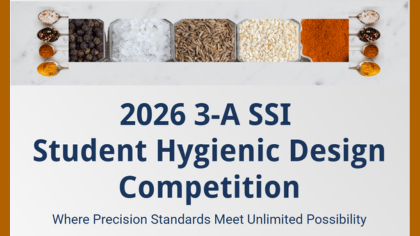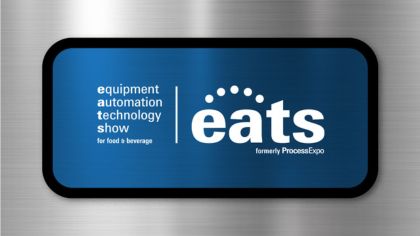



3-A SSI awarded eight dedicated food safety students with a Dr. Ron Schmidt Student Travel Award in 2025. These talented students attended the 3-A annual conference, presenting poster sessions on their areas of study. In the coming months, we’ll share their research in the 3-A SSI Blog.
This week, work by Michael Starnes, now a PhD student at Texas Tech University, is featured. In addition to the 2025 3-A SSI Dr. Ron Schmidt Student Travel Award, Michael was named a USDA Future Leader in Agriculture for 2025, one of only five graduate students nationally to receive this distinction.
Michael’s research focuses on Salmonella and E. coli mitigation strategies in beef and pork production.
See the poster Michael presented at the 3-A annual conference.
Do you know a student in food safety, equipment design or a related field? 3-A SSI has curated resources to help students build their expertise and launch a career in food safety and equipment design. Visit the new 3-A SSI Student resources.
Most in-plant validation research focuses on the use of microbial indicators such as aerobic plate counts, Enterobacteriaceae or generic E. coli to determine if the intervention is effective. While this approach is appropriate, some customers want a 5.0 log10 CFU/cm2 (or more) demonstrated reduction in indicators throughout the system. Because it is unlikely to find indicators at a level of 5.0 logs on the initial carcass samples, it is necessary to add surrogates to measure the reductions throughout the system.
Surrogate strains of E. coli that are non-pathogenic and mimic the behavior of pathogenic E. coli and Salmonella were developed to test the effectiveness of in-plant treatments in beef production facilities. While treatments can be tested for their efficacy within a laboratory setting, testing within the actual processing facility gives a much more accurate representation of overall cleanliness and effectiveness. Every possible condition within a processing facility cannot be accurately replicated within a laboratory, so it is critical to verify treatment effectiveness within the processing facility that will be utilizing the intervention. Pathogens, however, can’t be introduced into a facility, so there is a need to utilize pathogens surrogates to achieve the goal of plant behavior. The strains created and utilized for this study are ATCC E. coli strains BAA 1427,1428,1429,1430, and 1431 (ATCC 2024).
The objective of this study was to develop an industry standard for measuring a 5.0 log10 CFU/cm2 reduction in raw beef products throughout the processing chain, validating the use of multiple interventions.
Sampling indicated a consistent level of microbial reduction, with treatments on the hot carcass (day 1) having a higher level of effectiveness than on the chilled carcasses (day two). This difference in the level of reduction was expected.
This in-plant study was conducted in a beef harvest and processing facility to determine the overall bacterial reductions by multiple interventions used in the system over a two-day period (harvest and fabrication). To conduct the study, ATCC non-pathogenic surrogate strains of E.coli were utilized to mimic the behavior of Salmonella and E. coli. Foreshanks of beef carcasses were inoculated a total of two times per replications to ensure accurate measurement of the level of reduction.
On day one, cattle were harvested and 2 sides of each of the 2 foreshank were inoculated with the surrogate cocktail by spraying 10 ml on each side. Cocktail was allowed 20 minutes to attach. Samples were collected post initial inoculation which occurred on a rail-out just after the carcass was split and post hot carcass interventions of 2 lactic acid washes, 2 hot water washes, and 1 ozonated water treatment. On day two, after the sides were chilled, samples were collected from previously inoculated and treated carcasses. After the initial treatments, the foreshanks were reinoculated and sampled post reinoculation, and post chilled carcass treatments of 2 Crim Acid® washes and 1 ozonated water wash. Sample collection was performed utilizing 25 mL BPW pre-hydrated sponge swabs and a MicroTally Mitt, sampling the outside of the foreshank each time covering a total surface area of 100 cm2. Microbial loads were determined using spread plating techniques on MacConkey agar with a TSA overlay after 24 hours of incubation at 37°C.
Based on the findings in this study, an 8.0 log10 CFU/cm2 reduction from all combined interventions on hot carcasses followed by interventions on chilled carcasses to prevent microbial growth and kill potential contaminants. The sampling indicated a consistent level of microbial reduction, with treatments on the hot carcass (day 1) having a higher level of effectiveness than on the chilled carcasses (day two). This difference in the level of reduction was expected. It is well documented that antimicrobial treatments are more effective at higher treatments. Also, on the harvest floor (day one) the treatments included the use of two lactic acid washes, two hot water washes, and ozonated water. This multiple hurdle approach on the hot carcasses consistently yielded a higher level of reduction. Treatments were more aggressive and potent than day two, in which all carcasses were cold as opposed to hot. In conclusion, the operational procedure replicated during each repetition yielded consistent results for a clear demonstration of intervention efficacy. This standard of operation is replicable industry wide for antimicrobial treatment validation. As previously stated, research has previously been done at this plant by Portillo et al. to validate the effectiveness of treatments within the processing facility. These interventions were further validated by the results of this study, and my hypothesis that at least a 5.0 log10 CFU/cm2 reduction would be achieved was correct.

3-A SSI has launched an all-new program to recognize rising stars under the age of 40.

3-ASSI has launched an all-new Student Hygienic Design Competition. It gives students an opportunity to launch their careers while competing as part of an interdisciplinary team for bragging rights and a share of $10,000 in prize money.

The application is open for the 3-A SSI Dr. Ron Schmidt Student Travel Award. Recipients attend the 3-A SSI 2026 Summit on Hygienic Design, present a poster, and are treated to a VIP experience. After the event, recipients' research is published on the 3-A blog and promoted on social media. Many students land internships or full-time jobs as a result of the recognition.

After a productive and engaging PACK EXPO, the 3-A SSI team turns its sights to EATS and the IDFA DairyTech Conference.